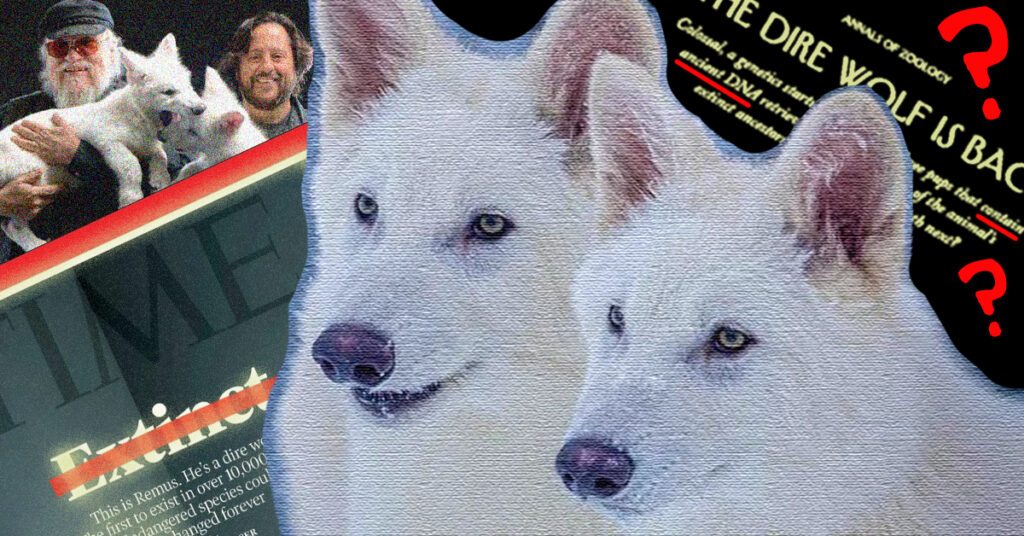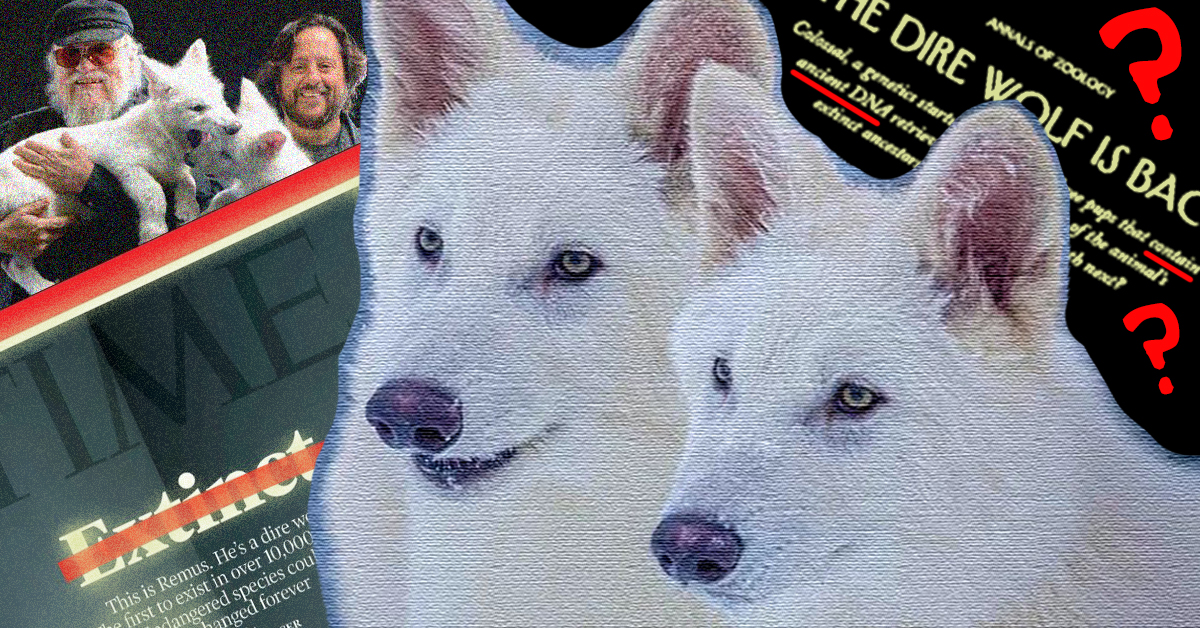
•U.S.-based Colossal Biosciences claimed that it resurrected the dire wolf, a canid that went extinct over 10,000 years ago, through de-extinction technology.
•Many scientists criticized the company’s announcement, noting that it produced gray wolves with edited genes, not true dire wolves.
•Excessively hyping “de-extinction” creates the misconception that extinctions can be reversed, spelling trouble for conservation efforts.
When genetic engineering company Colossal Biosciences revealed in early April that it had successfully brought an extinct species back to life — a Pleistocene-era predator known as the dire wolf (Aenocyon dirus) — the announcement came with a flurry of positive press.
TIME Magazine ran a full-length article and a “science behind” companion piece, with a cover showing Remus, one of the three pups, under the word “Extinct” struck out in red. “The Dire Wolf Is Back,” proclaimed The New Yorker. Meanwhile, The Hollywood Reporter declared that this “Isn’t Some ‘Game Of Thrones’ Fantasy,” referencing the book-based medieval drama TV series that introduced a fictionalized version of the animal (“direwolves”) to mainstream audiences. “Game of Thrones” author (and Colossal investor) George R. R. Martin even celebrated “D-Day” on his blog, sharing how he met Remus and Romulus (named after the mythological twin founders of Rome), who were born October last year, in February. The third pup, Khaleesi (referencing a tribal title from the show) was born in January, and is still too young for public appearances.
However, extraordinary claims require extraordinary evidence, not extraordinary marketing. It didn’t take long before scientists, science journalists, and science content creators worldwide created a de-extinction debunking dogpile, putting everything from Colossal’s press-release-before-paper approach to mainstream media’s sensationalist coverage under the microscope. But does this mean that the U.S.-based company’s de-extinction claim isn’t as, well, colossal as it seems?
What we know about dire wolves
Dire wolves prowled the forests, mountains, and grassy plains of North and South America from the upper Pleistocene (at least 125,000 years ago) to sometime between 13,000 and 10,000 years ago. Built for power instead of speed, dire wolves were formidable hunters, with slightly bigger bodies and a bite force approximately 30% stronger than gray wolves (Canis lupus), the animal we normally picture when we talk about wolves. These apex predators lived in packs, targeting giant animals (megafauna) such as ground sloths, mastodons, and prehistoric bovines. Today, the most abundant source of dire wolf fossils are the La Brea Tar Pits in Los Angeles, California.
According to 2021 research, dire wolves and living (extant) canines last shared a common ancestor approximately 5.7 million years ago, and any strong physical similarities between gray wolves and dire wolves were likely a result of convergent evolution (when two distinct species evolve similar features or behaviors due to experiencing similar living conditions or survival challenges over time). These findings also prompted paleoartists to update their dire wolf renditions with reddish-brown fur instead of the darker coats that gray wolves sport, an idea that made sense not only because of the dire wolves’ known habitat ranges, but also because it seemed less likely that they interbred with other canid species (which is how subsequent dire wolf generations would have acquired the darker fur trait).
Colossal’s chief science officer, Beth Shapiro, co-authored both the 2021 research and Colossal’s 2025 paper on dire wolf ancestry and evolution, which has been uploaded to bioRxiv and has not yet been peer-reviewed. Using DNA from a roughly 13,000-year-old incisor and an approximately 72,000-year-old “complete cranium with intact teeth,” Colossal’s team determined that dire wolves were the hybrid products of two extinct canids (and that dire wolves likely had white fur — curiously, exactly like the “Game of Thrones” direwolves). They also claimed that based on their analysis, the evolutionary split between the dire wolf and the gray wolf happened around 4.7 million years ago (1.2 million years later than previously estimated).
But is the dire wolf back or not?
So, how did Colossal go about “bringing back” the dire wolf?
There are three main methods of de-extinction. Colossal used two as the foundation of its dire wolf project: a cloning technique called somatic cell nuclear transfer (SCNT) — in which preserved cells from an extinct species are infused with the nucleus-free egg cell of a closely related living species, which is then implanted into a surrogate — and gene editing. (Selective breeding of an extinct species’ living relatives to produce an organism as close to the extinct species as possible, aka “breeding back,” is the third technique, and is the strategy employed by other groups to bring back animals like the quagga, a zebra relative, and the auroch, the ancestor of today’s cattle.)
After analyzing the dire wolf DNA, the team made 20 edits in 14 gray wolf genes, grew the cells into embryos, and implanted them in surrogate dogs to produce pups with the same size, fur color, and head shape as dire wolf pups. Colossal refused to provide specifics on which gene edits were made, as Colossal co-founder and CEO Ben Lamm told The New Yorker that this information is “company IP.”
It’s important to emphasize, though, that Colossal infused the egg cells with edited gray wolf cells, not actual dire wolf cells. In other words, there isn’t a single speck of dire wolf genetic material in Colossal’s pup. This is contrary to The New Yorker’s erroneous claim that the pups “contain ancient DNA.”
Following the phenotypic or morphological species concept, Colossal defines a “species” based on shared physical characteristics, which explains why they’re confident enough to call Romulus, Remus, and Khaleesi “dire wolves.” But many in the scientific community, particularly those who are well-versed in the nuances of species classification, have asserted that they are not true A. dirus, nor can they be considered members of a resurrected species.
“They’re more like gray wolves genetically modified to possess some (and that’s an important word here) dire wolf characters,” clarified Dr. Ronald Allan Cruz, an Associate Professor in Biology at Ateneo de Manila University who is not affiliated with Colossal. “They’re more like GMO gray wolves, so to speak.”
Defining de-extinction
Hearing the word “de-extinction” may conjure up ideas of resurrecting animals and plants that no longer exist. But that is impossible, at least in the present day — and to its credit, Colossal admits as much.
Creating a “100 percent genetically identical” copy of the dire wolf “is not really possible,” Shapiro told Scientific American. “But it’s also not the goal.” She stated that Colossal’s objective was to create “functional versions of extinct species,” in line with the company’s stated mission of rewilding — reintroducing long-gone species with important roles in the habitats where they once thrived. (The company also plans to bring back the woolly mammoth, the dodo, and the thylacine.)
In a 2016 paper, the International Union for Conservation of Nature’s Species Survival Commission (IUCN SSC) defined “de-extinction” as “any attempt to create some proxy” that can fulfill ecological roles unique to an extinct species or subspecies. Shapiro cited this in a video statement defending the company’s decision to call its dire wolf initiative a de-extinction project: “That’s not our definition; it was written by an international team of scientists, and no, I was not one of them.” Interestingly, the paper cites Shapiro herself when it explains that “none of the current [de-extinction methods] will result in a faithful replica of any extinct species,” which it uses as a supporting argument for its definition of “de-extinction.” Full circle, kind of.
Strictly speaking, the single “true” successful de-extinction — as in, an extinct species becoming “unextinct” or “de-extinct” through the use of technology — happened on July 30, 2003. Made possible via SCNT, a domesticated goat gave birth to a cloned Pyrenean ibex (Capra pyrenaica pyrenaica), a subspecies of wild goat that went extinct three years earlier. But the kid was born with a lung defect and died minutes later, tragically making it the only known animal in history to go extinct twice.
At this point, “Colossal’s wolf pups aren’t real dire wolves!” is a take as cold as the Quaternary ice ages. And it’s clear that at least some part of the debate revolves around terminologies, which the average person would probably react to with an indifferent “Eh, who cares? ‘Real’ dire wolf or not, it’s still cool science!” (which is exactly how Colossal is reacting to criticism).
But what should the average person really ponder about de-extinction, aside from its horrific (albeit somewhat exaggerated) consequences as depicted in pop culture (hello, “Jurassic Park”)?
The de-extinction agenda
De-extinction technologies aren’t just for bringing back dead species; they may help revitalize dying ones, too.
Revealed at the same time as the dire wolf announcement (but receiving considerably less attention) was the news that Colossal had also cloned four red wolves (Canis rufus), a critically endangered wolf native to southeastern America that used to be common before the 1960s. The clones will not be released into the wild, and will spend the rest of their lives under the care of Colossal. The company will gather data on them to develop better conservation and repopulation strategies.
With that said, there are other factors to consider (aside from just how viable lab-engineered clones would be in terms of genetic diversity, if they were to be released into the wild for repopulation purposes). As Cruz put it: “Given that so many red wolves have been killed by humans through shooting or vehicle collisions in the area where they’ve been placed, and extensive hybridization with coyotes has greatly diminished their genetic variability, it’s a futile exercise until those threats are removed.”
Rewilding challenges are even more apparent when talking about extinct species. With all the environmental changes that have happened in the dire wolf’s natural habitats in its millennia-spanning absence — including its prey that no longer exist, modern diseases and parasites that it has no biological defenses against (as they didn’t even exist in its time), and the potential of a “de-extinct” species to disrupt an ecosystem that has long moved on without it — one could not be faulted for doubting whether A. dirus could actually serve any meaningful purpose in the wild today.
But what about species that went extinct within the last couple of centuries and still have familiar ecosystems to return to? Even though there might be some merit to restoring recently lost species like the dodo and thylacine, it’s difficult to predict how genetic hybrids would fare when reintroduced into the wild. After all, there’s no guarantee that a functional proxy will behave the exact same way as the species used to. “We won’t be able to fully predict what its re-introduction will do to the environment because environments change so quickly, even within a few decades, especially with climate change and other anthropogenic factors,” explained Cruz.
As for Romulus, Remus, and Khaleesi, they will also live out their days in captivity, as they are unlikely to survive on their own in the wild. However, future Colossal dire wolves may have a home in North Dakota: Members of the Native American MHA (Mandan, Hidatsa, and Arikara) Nation tribes have expressed interest in adopting them, due to the cultural significance of wolves in their society.
Shoddy science reporting creates dire straits for conservation
De-extinction research may provide a possible (though indirect) boon to disease research. Plus, the revived species may generate increased interest from the government, the public, and other stakeholders in supporting conservation initiatives. But as the “breaking news” coverage of the Colossal dire wolves has shown, excessive science showmanship may end up doing more harm than good.
Just weeks after Colossal’s dire wolf announcement, the United States government put forward a proposed rule to rescind the definition of the word “harm” under the Endangered Species Act, a seemingly small change that almost certainly diminishes habitat protection for endangered species. In a post on X (formerly Twitter), U.S. Interior Secretary Doug Burgum wrote that “the marvel of ‘de-extinction’ technology can help forge a future where populations are never at risk,” emphasizing that Colossal’s dire wolf de-extinction project “heralds the advent of a thrilling new era of scientific wonder, showcasing how the concept of “de-extinction” can serve as a bedrock for modern species conservation.” This echoes Colossal’s bold but misleading claim: “Our goal is to make extinction a thing of the past.”
The problem is this: We can spend all day stretching or reshaping our definitions of “species” and “de-extinction” like modelling clay, but it won’t change the fact that a species lost is lost forever. There is no Ctrl+Z keystroke for extinction; the annihilation of a species is permanent. A genetically modified, as-close-to-the-original-as-possible copy can and will never be a true substitute for the original.
“Headlines like the one that appeared on the front cover of TIME magazine – with the word ‘extinct’ crossed out – seed a false hope that no matter what environmental damage is done, species loss can be easily undone,” argued experts from Europe and Australia in a jointly written essay for The Conversation. “The risk is that de-extinction will be used as an ultimate offset for any environmental impact.”
In a world where conservationists struggle to secure support and funding for biodiversity conservation, pushing the idea that manmade environmental destruction can be undone by simply editing a handful of genes — a narrative that greedy corporations, politicians with vested interests, and other bad actors can easily weaponize to their advantage — is disingenuous, dangerous, and deeply disturbing.
“Mainstream media has had a long history of irresponsibly ignorant reporting in the sciences,” lamented Cruz, noting that a more balanced approach that “highlighted criticisms against the project” instead of focusing on building it up would have made the early articles better from a science communication perspective.
On the bright side, the skeptical response of other science communicators to the initial positive wave of news is a sign that mainstream media’s science reporting is receiving scrutiny from the public, as it should. Moreover, the news about Colossal’s gene-edited gray wolves can admittedly ignite interest for genetics and biotechnology, which may encourage young students to become scientists.
There’s no denying that Romulus, Remus, and Khaleesi are marvels of modern science; their gene-edited genesis is an impressive demonstration of what today’s technology can accomplish. But there are other undeniable, uncomfortable truths that are impossible to ignore. Species extinctions are permanent. And even if we bring extinct species back, they will simply die out again if we don’t fix the problems that caused their extinction in the first place. Biodiversity conservation may not sound as hip or sexy as de-extinction technology. But it is less expensive, more effective — and simply the responsible thing to do.
“There is a real problem in global extinction and there are many ways to mitigate that problem, including biotechnology,” said Cruz. “Let’s all care about extinctions first.”—MF
Author: Mikael Angelo Francisco
Bitten by the science writing bug, Mikael has years of writing and editorial experience under his belt. As the editor-in-chief of FlipScience, Mikael has sworn to help make science more fun and interesting for geeky readers and casual audiences alike.









